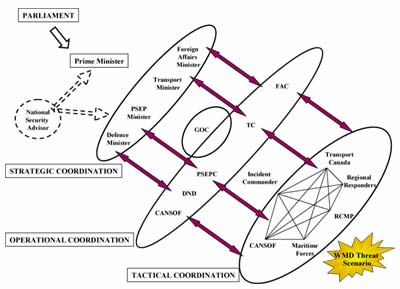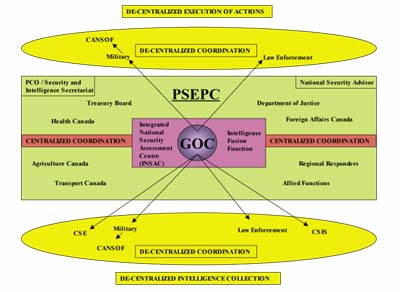 This information has been archived for reference or research purposes.
This information has been archived for reference or research purposes.
Archived Content
Information identified as archived on the Web is for reference, research or recordkeeping purposes. It has not been altered or updated after the date of archiving. Web pages that are archived on the Web are not subject to the Government of Canada Web Standards. As per the Communications Policy of the Government of Canada, you can request alternate formats on the "Contact Us" page.
Interagency Coordination
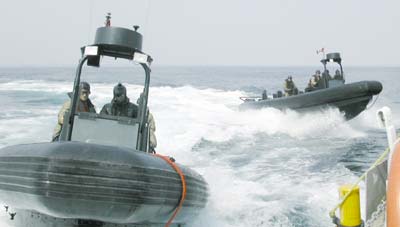
DND Photo DHD 02-292-07
JTF 2 troops on a waterborne exercise.
Interagency Coordination Within the National Security Community: Improving the Response to Terrorism
For more information on accessing this file, please visit our help page.
Preventing terrorist activity very much depends on the collection, analysis and dissemination of information and intelligence, and on cooperation between jurisdictions, levels of government and the private sector.
– Government of Canada’s Response
to the Report of the Special Senate Committee
on Security and Intelligence (1999)
By dint of concerted senior leadership efforts over the past decade, Canadian Forces joint operations capabilities have matured significantly. But, in the current strategic environment, the important new imperative is to go well beyond that and to integrate the Canadian Forces’ operations capability with that of several other agencies that contribute to Canada’s national security. The whole of the national security community must come together to work as a team to counter the current threats to our national interest, at home and abroad. The collaborative efforts of a coherent, networked national security ‘team’ show promise of great improvement over the sum of the individual and often isolated efforts of a number of government departments and agencies.
The effort has already begun in earnest. In December 2001, the government pledged over $7.7 billion for specific initiatives that contribute to national security and pursue the improvement of the interagency coordination process.1 One such undertaking was the establishment of the Department of Public Safety and Emergency Preparedness Canada (PSEPC) in December 2003. This new department brings together six core functions: crime prevention, policing and enforcement, security and intelligence, corrections, border services and integrity, and emergency management.2 Another key move was the appointment of Robert A. Wright as National Security Advisor to the Prime Minister. His office will become a strategic focal point to “coordinate integrated threat assessments, help strengthen interagency cooperation, and assist in the development of an integrated policy framework for national security and emergencies”.3
While the Department of National Defence is a major component of the national security team, Canada’s interests in what has been called the Global War on Terrorism narrows the immediate focus to the integrated collection of intelligence and taking action against selected terrorist targets, which will involve mainly law enforcement agencies and Special Operations Forces (SOF).4 Although interagency coordination is indeed required throughout the entire federal government infrastructure, this article will focus on the departments and agencies directly involved in combating terrorism and thus have an immediate need to coordinate their activities. The article will first examine what interagency coordination entails. From that base, it is possible to construct a framework model of the process. The article will argue that the consequences of not integrating the intelligence, law enforcement and SOF communities entail significant risk. A collaborative effort of the national security community will better position the government to cope with an unpredictable threat environment, and help protect the Canadian public from an attack similar in magnitude to that of 9/11.
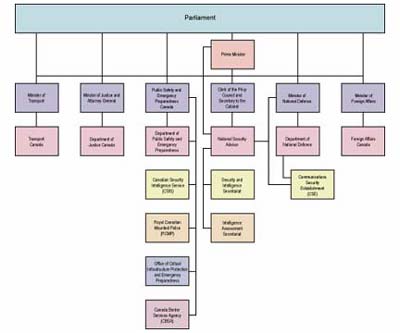
Figure 1. Canada’s Agencies With Security Roles. (From Canadian Intelligence Resource Centre5) - Larger Version
Interagency Coordination
Interagency coordination is a concept that is somewhat difficult to define without an adequate frame of reference. But, in the context of the military and the national security community, interagency coordination can be seen as the interaction and organizational synthesis that occur between elements of DND, other government departments and agencies, and regional and international organizations to achieve a common national security objective. Figure 1 shows the agencies and departments involved in Canada’s security and intelligence community.
The rigidly hierarchical structure of government bureaucracy, as illustrated in Figure 1, is simply not conducive to effective interagency coordination or to the integrated response required to cope with a common threat. In that sort of structure, the natural tendency in a crisis situation is to adopt a ‘close-hold’ posture because of operational security. Fortunately, among organizations with similar objectives, ad hoc relationships do develop at the tactical level that eventually allow for mutual understanding of agency tactics, techniques and procedures. But that alone does not ensure the integration, analysis and dissemination of ‘actionable’ intelligence, and thus puts at risk the attainment of strategic or operational results. To be of real benefit, the interagency coordination process must be formalized down to the operational level, and must be practised in peacetime as well as throughout all phases of conflict. The onset of a crisis is not the time to begin to develop working relationships and the accompanying nuances of understanding within the national security team.
The federal government has recognized the requirement for interdepartmental collaboration, and, as mentioned earlier, has recently restructured key agencies and departments to assist in the combined efforts required for combating terrorism. The Department of Public Safety and Emergency Preparedness Canada is the operational focal point for interagency coordination in matters of national security interests for Canada. The new department, under Deputy Prime Minister Anne McLellan6, has brought together the key emergency response elements from several core departments and agencies for more efficient coordination of their efforts,7 and it synchronizes responses to emergencies through a national operations centre.
PSEPC’s Government Operations Centre has been given the mandate to “provide strategic-level coordination and direction on behalf of the Government of Canada in response to an emerging or occurring event affecting the national interest”.8 This mandate is certainly novel, indeed almost revolutionary, for Canada in that it is likely the first time a national response centre will have directive powers over the supporting and supported organizations. (One could argue that legislation might be required for this directing authority to be realized.) While each department and agency will continue to have its own strategic/operational focus and interagency coordination responsibilities, they all are to function in accordance with direction outlined in Canada’s new National Security Policy, published under the title Securing an Open Society.
The Government Operations Centre is designed to be the central node for communications and support so as to provide a multi-faceted source of intelligence and knowledge transfer (See Figure 2). It should be noted that not all the key players are included in this interagency model; each separate incident or threat response is likely to involve different organizations, and the structure will thus be adjusted to satisfy the particular operational requirement.
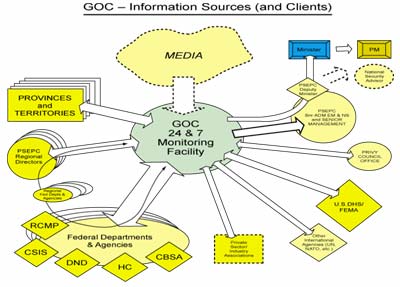
Figure 2. Government Operation Centre – Interagency Process. (From PSEPC Presentation9) - Larger Version
If one were to examine a hypothetical Weapons of Mass Destruction (WMD) proliferation situation where Special Operations Forces are likely to be engaged, the interagency coordination structure might resemble that shown in Figure 3. This simplified scenario might portray an attempt by a terrorist organization to smuggle radioactive material in conjunction with high-yield explosives into an obscure inlet on the southern coast of British Columbia. The background to this story would show that this terrorist organization had been scheming to blackmail the Canadian government into withdrawing its military contingent from Country X, threatening imminent destruction should it fail to comply. The scenario could evolve with the premature detonation of the radioactive material and the subsequent contamination of a densely populated area.
Note that Canadian SOF are shown as an addendum to DND’s coordination link within the national security team. Because of the specialized nature of the SOF and the limited resources and capabilities that they are capable of contributing, they will normally be involved only if resolution of the situation requires the use of force or a particular skill set. A core principle of planning for special operations is early inclusion of SOF planners in the higher headquarters in anticipation of a serious crisis. Because of the nature of operational security, this model is more concise than it might be for a natural disaster or pandemic scenario such as SARS.
The Global War on Terrorism
It was only after the Al Qaeda attack on 11 September 2001 that the West came to the realization that it was ‘at war’ with a formidable opponent. In Canada, security-related agencies and organizations had maintained separate and very independent goals and methods until it was recognized that there was a common enemy that required a concentrated effort. Nonetheless, Canada’s reaction to recent major events has demonstrated a continuing weakness in the links between departments. As an example, the power outage in Ontario and the northeastern United States in August 2003 highlighted several serious gaps in communications links and showed that substantial improvement was required in the interagency coordination arena.10
Although it can be convincingly argued that coordination among agencies should be institutionalized to some degree, most would also agree that the interagency process does not have to be embodied under a single authority. In an article in The Hill Times, Deputy Prime Minister McLellan acknowledged that the Public Safety and Emergency Preparedness department has been likened to a smaller version of the US Department of Homeland Security. That American super-structure organization has come under fire from critics who charge that it is simply too large to work effectively.11 It is indeed possible that too much unity and integration can overwhelm a highly centralized system and eliminate independent thinking among the different component agencies that promotes effective and timely decision-making. Thus, while streamlining the coordination process is undoubtedly essential, it can also be argued that executive actions should remain independent and decentralized.
McLellan has stated that she will integrate only where it makes sense.12 There are however, organizations such as the Canadian Intelligence Security Service, the RCMP and DND where an improved coordination process is required. Intelligence, law enforcement and SOF do have completely independent functions, and each understands its own operating capabilities better than other counterparts in the national security domain. It makes sense for these organizations to remain independent, but to improve the interagency harmonization between them.
While other departments and agencies often have significant roles for public safety, the principal interagency nodes for the ‘Global War on Terrorism’ are the following departments and agencies:
Intelligence
- Security and Intelligence Secretariat of the Privy Council Office (PCO)
- Canadian Security Intelligence Service (CSIS)
- Communications Security Establishment (CSE)
- National Defence Intelligence Centre (NDIC)
Law Enforcement
- Department of Justice (DOJ)
- Royal Canadian Mounted Police (RCMP)
- Canada Border Services Agency (CBSA)
Military
- Department of National Defence (DND)
- National Defence Headquarters (NDHQ)
- Canadian Special Operations Forces (CANSOF)
- Canadian Forces Joint Nuclear Biological Chemical Defence Company (CFJNBCD Coy)
- Joint Task Force Two (JTF 2)
To combat terrorism effectively, the interagency coordination model has to be a reasonably concentrated body or an executive committee capable of harnessing the full potential of the various agencies. Although cultural differences and the absence of a single executor for all the resources may impede efficiency, stable and habitual working relationships within the intelligence, law enforcement and SOF communities will foster cohesion and trust that will enhance the productivity of all. A permanent but small interagency liaison staff will always be more effective in managing the coordination of complex issues than an ad hoc team that is assembled only in an emerging crisis. Then too, members of an ad hoc team are likely to continue to have other high priority responsibilities within their own organization, and perhaps also divided loyalties.
There is, of course, a balance to be struck between a relatively small coordination body and one that is too small. In the counter-terrorism community, there is usually a tendency to keep the number of main action groups as small as possible because of operational security, as well as to expedite the decision-making process with regard to time-sensitive targets. But, the rapid execution of a complex plan that is not well coordinated among all participants is a recipe for disaster. The interagency coordination efforts for Operation “Eagle Claw”, the ill-fated Iranian hostage rescue attempt in 1980, is a case in point: a complex plan that was not well coordinated, with disaster being the result. In that operation, the CIA and the military failed to coordinate their activities effectively, and too many of the military combat elements knew only their own specific portion of the overall plan, which prevented them from making informed decisions when things began to go awry. It is true that as the number of involved agencies and departments increases, the coordination process becomes increasingly difficult to manage, but the right balance always needs to be found taking account of the relative importance of operational security, decision-making speed and the number and role of the participants.
While it is suggested that an institutionalized approach is essential, it is only the process of coordination that needs to be institutionalized. The asymmetrical threat that confronts us is simply too unpredictable to establish a fixed structural organization.
David Tucker, a defence analysis at the Naval Postgraduate School in Monterey California, has suggested that there are three characteristics of the interagency process: “It is a network disguised as a hierarchy; it incorporates different decision modes and speeds; and it has horizontal and vertical dimensions”.13 The network/hierarchy paradigm may appear to be contradictory, but a network and a hierarchical model complement each other in terms of functionality. Within a hierarchy, decisions can be made rapidly because of its centralized authority, whereas in a network the decision-making model can be complex and slow. The interagency coordination network is adaptable, and its flexible form makes it resilient in the asymmetric threat environment, whereas a hierarchy may be less accommodating and susceptible to partisanship. In the interest of public safety, the interagency model should resemble both a network and a hierarchy. Figure 3 depicts a hierarchical representation, while Figure 4 shows the mechanics of the interagency coordination process in a refined national security network.
At the top of the hierarchy is the federal government represented by the Deputy Prime Minister, down through the National Security Advisor and the relevant departmental headquarters. The national security interagency community is also networked through bilateral agreements, service-level agreements, the Department of Public Safety, inter-service liaison and working groups, as well as the newly appointed National Security Advisor’s office. Horizontal lines of coordination are created within the individual departments; DND is a good example, with the SOF engaged on a parallel level to the department.
Fine-Tuning the System
The question remains: Is the current framework for interagency coordination in Canada suitable for the contemporary security environment? The direction in which the government is moving is certainly a vast improvement on the policy and procedures in place before September 2001. It was not so much that the departments failed to coordinate activities amongst themselves, but prior to the terrorist attacks in the United States they simply lacked the common focus of a legitimate threat to our national security. Although cultural differences and internal political struggles will always be factors affecting proper coordination, a common threat-oriented objective appears to have overcome indifference; ignorance of the process, traditional barriers and interdepartmental politics often inhibit efficiency. Some security environment agencies are unsure of their counterparts’ roles, responsibilities and capabilities, which can lead to unnecessary duplication of effort. All components of the security community must develop an understanding of the capabilities and roles of the other departments and agencies that have a role to play in national security so as to strengthen the trust and cohesive relationships between the partners.
The National Counter Terrorist Plan provides a rudimentary framework for coordination of Canada’s counter-terrorism programme, but it lacks the detail needed to provide leading agencies with authoritative powers. The Solicitor General’s initiative to establish the Integrated National Security Assessment Centre now enables a collaborative approach to intelligence analysis and dissemination, but these efforts have not yet resulted in a comprehensive, integrated collection plan. Additionally, Canada’s ability to respond to terrorist threats has been strengthened considerably by the appointment of a National Security Advisor to the Prime Minister to oversee the integration of intelligence and inter-governmental coordination, along with strong leadership in the Department of Public Safety and Emergency Preparedness.
These initiatives all contribute to an enhanced security environment for Canadians. However, whether the Public Safety Department is truly capable of responding to incidents and coordinating an emergency response to a national crisis can still be questioned, as well as whether it has the resources and authority to deal with counter-terrorism issues. The body responsible for counter-terrorism must be small enough to maintain operational security, yet all-encompassing enough to facilitate effective coordination across the agencies. One model that might meet the bill would be a Combined Counter Terrorism Task Force. For example, in the United States the FBI’s Joint Terrorism Task Force consists of an intelligence arm and an executive action arm subject to one authoritative body, albeit functioning only in a domestic capacity.14 In contrast, PSEPC relies on the Integrated National Security Assessment Centre, which is based at CSIS Headquarters, for its intelligence. It then allows traditional jurisdictional roles – the RCMP or DND – to ‘lead’ for a particular incident. There is no centralized command, which is in contrast to the task force model.
The task force model presents an option that would link intelligence analysis to the action arm and so create a comprehensive, web-like focus for countering terrorism. The operational terrorism task force teams could be specialized by region, by terrorist organization, or by domestic and international jurisdictions. There would still be a requirement for the Integrated National Security Assessment Centre and PSEPC functions, but their focus would remain at the strategic level. The hierarchical structure within the task force itself, together with the external, networked capability to call on parent organizations for support, would, it is believed, enhance interagency cooperation. The representatives of each agency in the task force would be part of a “special” team, which would generate loyalty to that specific terrorism task force. At the same time, the agency representatives would maintain ties with their own higher headquarters. All pertinent agencies would be represented in the task force, but command of the task force would be adapted to the particular situation. For a domestic terrorism issue, for example, command might be delegated to an RCMP officer. A delegated Foreign Affairs official might take the lead during an international terrorism incident. Or, should the resolution of the crisis require military force, it could be a SOF officer. However interagency coordination is viewed, it is evident that some form of legislation is likely to be required to break down cultural barriers and differences of operational bias within the national security community.
Conclusion
The interagency coordination process is difficult to portray on a line diagram because it incorporates a combination of hierarchical and network structures. The ‘players’ are easy enough to identify, as are their independent functions, but the subtle nuances of interaction amongst the involved agencies are difficult to put in simple form.
In outlining the PSEPC model for interagency coordination, and identifying all the players with security roles in Canada, the magnitude of the interagency coordination problem is clearly shown. As previously mentioned, DND is an important component of the national security team, but it is evident that the military is not the central figure, and the role of SOF seems even less significant. The vital aspect of the interagency process remains the integrated coordination of intelligence – collection, analysis and dissemination. Law enforcement agencies and SOF can, of course, play pivotal roles in collecting intelligence and acting on it. And, the establishment of the Integrated National Security Assessment Centre has been a giant leap in the management of intelligence.
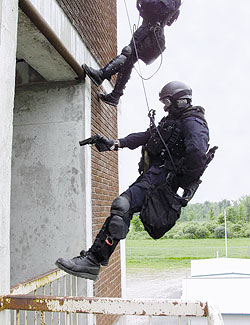
DND Photo DHD 01-053-31
Members of JTF 2 practicing entry into a building.
The hypothetical Weapons of Mass Destruction scenario discussed earlier shows a possible interagency coordination model in which PSEPC’s Government Operations Centre would still remain a focus. But, the magnitude of the terrorist threat has forced defence analysts to look at alternative means of countering terrorism. The Combined Counter Terrorism Task Force model outlined in this article represents, of course, only one option that could be refined to enhance the working relationships within the national security community.
Regardless of the interagency differences, the security community must now bond together to create a cohesive model structured to defeat the collective threat. It is the common objective that must prevail.
![]()
Major Tim Lannan is a staff officer with the Counter-Terrorism/ Special Operations Cell at NDHQ.
Notes
- Canada, Department of Finance, (2001), The Budget Plan 2001 – Chapter 5, “Enhancing Security for Canadians”. Retrieved 13 August 2004 from the World Wide Web: http://www.fin.gc.ca/budget01/bp/bpch5e.htm
- Canada, Department of Public Safety and Emergency Preparedness. Retrieved 5 August 2004 from the World Wide Web: http://www.psepc.gc.ca/publications/news/20031212_e.asp
- Canadian Embassy to the United States Web Site, “A Strong Security Partnership.” Retrieved 5 August 2004 from the World Wide Web: http://www.canadianembassy.org/defence/quotes-en.asp
- Canadian Special Operations Forces (CANSOF) encompasses Joint Task Force Two (JTF 2), the Canadian Forces Joint Nuclear, Biological, Chemical Defence (JNBCD) Company, and the national headquarters element – J3 Counter Terrorism/Special Operations (J3 CTSO) staff – at NDHQ.
- The Canadian Intelligence Resource Centre, “Agencies With Security Intelligence Roles”. Retrieved 16 August 2004 from the World Wide Web: http://circ.jmellon.com/docs/view.asp?id=663.
- The mandate of the Minister of Public Safety and Emergency Preparedness Canada is currently a suitable fit for the Deputy Prime Ministers’ portfolio, but PSEPC may develop into a more demanding department and the portfolio may be split.
- PSEPC consists of the following six agencies: Royal Canadian Mounted Police (RCMP), Canadian Security Intelligence Service (CSIS), Correctional Services of Canada (CSC), National Parole Board (NPB), Canada Firearms Centre (CFC), and Canada Border Services Agency (CBSA).
- Presentation delivered by the Director of the Government Operations Centre, PSEPC, 20 August 2004.
- Ibid.
- Although the government’s self-assessment reported that the handling of the situation was effective, the report also identifies weaknesses that still must be addressed. All are related to coordination efforts among other government departments and the US. A full report can be retrieved from the World Wide Web: http://www.ocipep.gc.ca/info_pro/NewsReleases/NR03-1709_e.asp.
- The Honourable Anne McLellan, as cited in an article by Paco Francoli in The Hill Times: Canada’s Political and Government News Weekly, National Security Policy Briefing, Monday March 8-March 14, 2004, p. 1.
- Ibid. p. 21.
- David Tucker, “The RMA and the Interagency: Knowledge and Speed vs. Ignorance and Sloth?”, Parameters, US Army War College Quarterly, Autumn 2000.
- Robert A. Martin, “The Joint Terrorism Task Force: A Concept that Works”, Law Enforcement Agency Resource Network. Retrieved 16 August 2004 from the World Wide Web: http://www.adl.org/learn/jttf/default.asp.

DND Photo IS2004-2148a by Sergeant Frank Hudec
A Canadian Forces CH-146 Griffon helicopter returning to Pangnirtung airport after picking up two soldiers who had become stranded in the surrounding mountains, August 2004.



